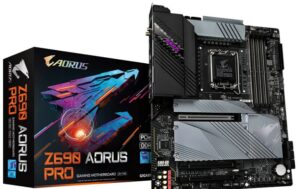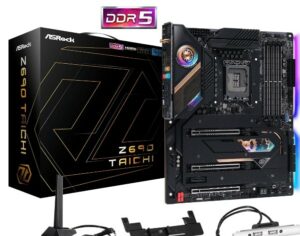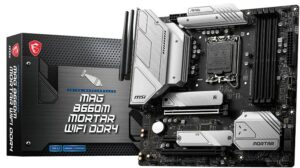Motherboards are the center of your PC. They connect everything, and they are the platform for upgrading your computer.
Your motherboard is dependable and equipped with the most recent hardware. If you know what to look for, selecting a motherboard is simple.
Before you start buying a motherboard, you should ask yourself several questions.
How big is your computer case? Do you desire the ability to overclock your CPU? Do you require high-performance RAM?
Is it necessary to disable USB ports? If your wish list grows, expect to spend more. However, it isn’t always bad, especially if you haven’t replaced your motherboard in years.
This brings us to an important point about motherboards: Proof of the future. If you are in it for a long journey, you need to ensure that the board socket or chipset is equipped with advanced processors such as Intel’s Z690 chipset and its Alder Lake chips or AMD’s X570 chipset and can support a durable AM4 socket.
It makes it an easy task to upgrade whenever the cost of these CPUs drops.
Over the last year, I’ve experimented with many AMD and Intel motherboards, from the Mini-ITX to the E-ATX, so you can decide which one is best.
Here is the list of some premium quality motherboards that you need for gaming PC:



1. Gigabyte Z690 Aorus Pro
It was almost inevitable that the top-end chipset would be too expensive for Intel’s next-generation Elder Lake CPUs.
It is a premium blend with anything that mentions DDR5. Nonetheless, the Gigabyte Z690 Aorus Pro mitigates this trend by offering a round feature set with DDR5 support for around $ 330.
Certainly, CP 300 + was seen as high in the previous CPU generation, but for the 12th General Platform, which is positively moderate.
There are cheap DDR4 boards around – AGROS Pro also makes gigabytes in DDR4 flavor, although it doesn’t sell in the US or EU – if you want to get the most out of the new Intel platform, you want DDR5.
Gigabyte has been cautious about this, as he has described the Ors Pro. By limiting it to ‘only’ Wi-Fi 6 wireless (as opposed to Wi-Fi 6E) and 2.5G Intel wired networking connections, and avoiding unnecessary luxuries like the Thunderbolt 4 or any other M.2 slot, Done. Price at least relatively sensible.
Pros
- Four M.2 slots
- 13 rear USB ports
- Strong VRM
Cons
- Gray metal may not blend into your construction.
- Wi-Fi 6 only
2. ASRock Z690 Taichi
When ASRock launched its Taichi brand for the first time, we were impressed with its minimalist design style.
It offers a great feature set and value for money without the excessive RGB overload common on gaming boards a few years ago.
This brand has now become a truly superior brand. The unseen Aqua is the company’s top model yet, but with the nature of its expected limited edition and possibly a stratospheric price, the Taichi will essentially be ASRock’s premium Z690 motherboard. And this is not a bad place.
The board’s shape is unique, and although in the viewer’s eye, the Cyber Punk theme, with its copper accent and cog, sounds great to me.
The cogs above I / O move, and you get a good splash of RGB. It seems expensive. Also, if you’re a fan of Razer products, there’s a Razer-themed Z690 Taichi for easy integration into the Chroma ecosystem.
In particular, Taichi performed well in gaming tests, often leading the pack. Although 1 fps is not important here or there, it is better to go beyond the trail.
The board supported DDR5-6400 memory, which not all Z690s could. It indicates a high level of maturity, though, with brand new platforms and standards, some refinement is likely.
Pros
- Dual Thunderbolt 4 Type-C
- Mega VRM
- Good networking
Cons
- Only three M.2 slots
- Like all advanced Z690 boards, it is expensive.
3. MSI MAG B660M Mortar WIFI DDR4
Slightly more affordable than some of the Z690 boards out there, the Alder Lake option, this MSI MAG B660M Mortar WIFI DDR4, offers some luxury yet a combination of impressive features.
Not only are we seeing great power design, but this little micro-ATX board manages to fit eight USB ports on the back panel (including a USB 3.2 Gen2 Type-C) and a bunch of internal headers. ۔
There is no overclocking capability or DDR5 support, but considering that this is one of the more affordable routes on the Elder Lake platform, it makes sense to go down the DDR4 route. The DDR5 version is available in the UK, but we couldn’t find it in the US.
One obvious thing missing from the feature list is support for PCIe 5.0 graphics cards, although given that no such cards currently exist, this is not the shortcoming you might think.
Everything else is present and accurate, though a strong x16 PCIe 4.0 slot for the GPU, another full-length slot running on x4, and a final, short x1 PCIe 3.0 slot.
The fact that you get a pair of PCIe 4.0 M.2 slots for your drives will suffice for most users.
Pros
- Solid feature set
- Good power design for mainstream
- Can power stock i9 12900K
Cons
- There are Z690s at this price
- No support for PCIe 5.0
- B660 frame rate sacrifice in games
Final Thoughts
There are strict restrictions to prevent this, especially from Intel. It has unlocked memory in its 500 series chipsets, but the Z590 is the only chance for you to overclock the latest Rocket Leak K-Series CPUs. But don’t worry, they don’t overclock very well.
AMD is more generous, allowing all its CPUs and most of its motherboard chipsets. If you make sure you don’t go for the cheapest resin board with an ‘A’ in front of its name, you’re good to go. Again, there are really limited returns.

